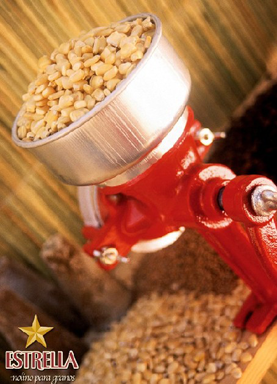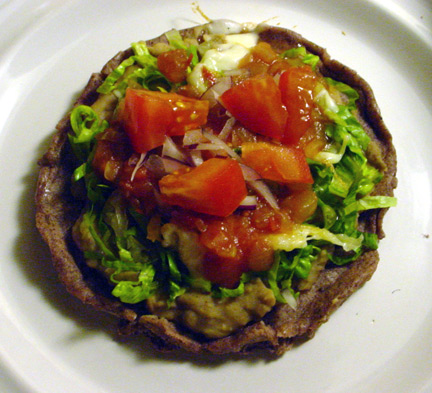The Corona mill isn't a grain mill, it's a corn mill. Got that?

Catalog page circa 1929.
I'll admit it took me a long time to figure this out. I've been aware of these mills way back in the early 1970s when I used to subscribe to Mother Earth News magazine and dreamt of a life of subsistence farming to replace the suffocating suburban lifestyle of a twenty year old. Buy whole wheat in bulk and grind your own flour for pennies!
To this day, people buy these things and then complain at how totally useless it is for bread flour.
“I bought this for the sole purpose of making bread flour. I got it, set it up, put some wheat into it, tightened basically as far as it would go, and the berries came out almost exactly as they went in. Plus, there were little iron filings from the burrs mixed in. Great.”
reported an unhappy customer on Amazon's Weston Cereal and Multi-Grain Mill customer review page.
The original Corona mill was developed by Landers, Frary and Clark of Connecticut some time before 1900 and was apparently sold worldwide. In 1951, a company, LANDERS Y CIA. S. A., was formed in Columbia to make these for home nixtamal production. It still produces this ancient cast-iron, hot tin plated mill along with Columbian rival Victoria, and the Mexican-made mill Estrella. These three mills are virtually identical, the Estrella being painted rather than tin-plated. There are many other brands of the same-design corn mills and I believe those are made in China (note the rubber pad on the upper part of the clamp).


Victoria and Estrella mills.
I've been making more tortillas and other pan breads lately because summer weather makes oven baking a sweaty pain in the ass. I had been using dried masa harina and the result is much better than store-bought tortillas. Realizing that GMO corn is the norm these days, I went looking for organic masa harina and didn't have any luck. I can get whole organic corn from my local co-op for only about $0.50 a pound if I buy it in 25 lb. bags, so why not get one of those cheap mills and make the good stuff myself? Ebay has new Coronas for $64.29, Victorias for $60.24 and the Estrella for $58.99, including shipping. Shipping is a killer for these heavy cast-iron mills.
I found a used Corona for $24.50 with $8.99 shipping. I later found the all-time best deal at Amazon for a new Victoria Corn Grinder at $34.99 with free shipping (I had been searching for 'grain mill' and missed it).

My dirty and scuffed Corona mill of unknown vintage.
When I received it, I took it apart and washed it in hot soapy water. The scuff marks didn't disappear, and I found a bit of rust inside. I lightly oiled the whole thing with food-grade mineral oil (baby laxative). The grinding burrs show little, if any, wear. Perhaps it was originally owned by someone who expected to make bread flour with it!
There's just one Mexican grocery in the county where I live, so next time I was in the area, I picked up some reddish blue whole corn and a little package of Cal (slaked lime). I tried grinding some of the untreated dry corn and the mill was a lot stronger than I expected! Corn meal, grits or polenta is easily ground with by adjusting the coarseness of the grind. A few days later, I made some fresh tortilla masa.

Rinsed whole corn.
Rather than explain the whole nixtamalization process, there's a video on Youtube of the Alton Brown's excellent show "Tort(illa) Reform" that was written by professionals.
I used the recipe from that show for my masa. I've seen similar nixtamalization recipes on the net for tamales and posole that require longer cooking times than for tortillas.

Finished fresh masa. The wet corn went through the Corona so easily. No metate for me! The nixtamal smell is a lot less strong than when using dried masa harina. My kitchen lights don't show enough of the blue spectrum.
Then I made some extra-large sopes.

I hand-formed the very thick tortilla. Cook on a medium hot pan for about 30 seconds, then flip over and cook the other side for about 1 ½ or 2 minutes.

Remove the tortilla from the pan, flip it most-cooked side up and form a little lip around the edge. Return the tortilla to the hot frypan and spread with refried beans.

In another pan quickly fry a bit of good-quality mozzerella, string cheese or Oaxaca cheese. I used a not-so-good quality mozzerella here and it spread like butter.

Add shredded lettuce to the sope and top with the fried cheese. My cheese turned to glop.

Finally, add salsa, onion and chopped tomato.
Tortillas made from fresh masa taste and smell much better than ones made from dried masa harina, which in turn are much better than store-bought corn tortillas.
I've since made great peanut butter with my Corona, and expect that I can do from-scratch falafels by grinding soaked chickpeas. If I wanted to make my own tofu, it would be great for grinding soybeans. The home-brewing crowd uses these to crack malted barley for beermaking. Survivalists tout these as necessary items to have on hand for the ever-impending collapse of civilization.
I saw that flour-mill maker Retsel offers stone grinding-wheel kit for Coronas for only $29.95, but I still don't think the fit of the Corona mill is precise enough to get good flour from them. It's corn mill, remember?
- Crider's Blog
- Log in or register to post comments
Wow, that was quite an education I just got in your interesting post. I now understand the basic difference betweeen a corn mill and a grain mill. But your account and pictoral display of turning corn into tortillas is really wonderful, and the finished product looks delicious! We're having the same weather on the East Coast, so recipes like this that avoid the oven are really enticing.
Thanks for the history lesson...and the great looking dinner!
Larry
It was a delicious dinner!
The color matches what I've got. I wasn't sure at the time if I had a blue corn or a red corn. The store also carried white corn.
Thanks for a great post and some interesting photos. About seven years ago I was in the Republic of Moldova for a year. It is a corn growing country and their version of polenta, called "mamaliga" is a country-wide staple. There were not that many supermarkets, and only one sold corn tortillas - the preformed, prebaked shells for tacos, imported from Turkey. The price was about USD 9 for a small package of 8 shells - far beyond the budget of most Moldovans. So I decided to try making them. After some searching and questions, I came up with a recipe for nixtamal, calling for dried corn kernals and some calcium hydroxide. Not likely to fiond it in the capital, I shelved the idea for a while. Then a few months later, visiting a friend's rustic country house, I noted a medium-sized trough set up over a small outdoor campfire, in which a white liquid was bubbling away. When I asked, he explained that they bought some white rocks from traveling gypsies, then boiled the rocks inwater to dissolve them and used the liquid to paint the bottom meter of the hardwood trees on the property (to keep the ants off the trees). My friend fed the small granules which did not dissolve to his chickens to strengthen the shells of theior eggs. I realized that the white rocks were limestone and figured out that he was making calcium hydroxide. He gave me 500 grams of the granules, as well as some dried corn kernals which he kept to feed his pig.
Back home, I follewed the recipe I had obtained and boiled up the kernals in several quarts of water to which I had added some of the cal. After a short boil, turned off the heat and let them soak overnight, rinsing them the next day. Now to grind them. A housekeeper had an old Soviet-made meatgrinder, which looked something like the Victoria in your photos. The hopper was small, so this was a several hour project fro a smowy, winter day. Grinding a small amount with the large plate, then adding more until all had been ground. Changing plates to the medium size holes gave me a finer consistency, and then finally passing everything through the small holed plate gave me a masa ready to use.
I rolled out some of the dough between plastic sheets, then used a large coffee can to cut circles, got the dough to the skillet to cook and then set aside to cool. I found I could make a dozen or so at a time, and store the rest of the masa in the freezer. After cooling, the tortillas were wrapped and stored in the freezer as well. They were delicious, cooked up into tacos or tostadas. They lasted me for a while that winter and I had enough to share with friends. Admittedly they were used to their polenta-style mamaliga and so thought these a strange invention, but they enjoyed them nonetheless.
Again, thanks for the post. It brought back fond memories.
Bob
right down to the old Soviet meat grinder. Things seem to taste better when done with available tools and methods.
A friend pointed out that old Mother Earth News articles are archived on their website and user enough, I found the article that had piqued my imagination so many years ago.
http://www.motherearthnews.com/Modern-Homesteading/1971-01-01/Possibilities-With-Corona-Grain-Mill.aspx
I'd like to read of experiences milling corn with the Bell #2 mill.